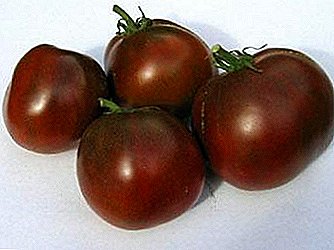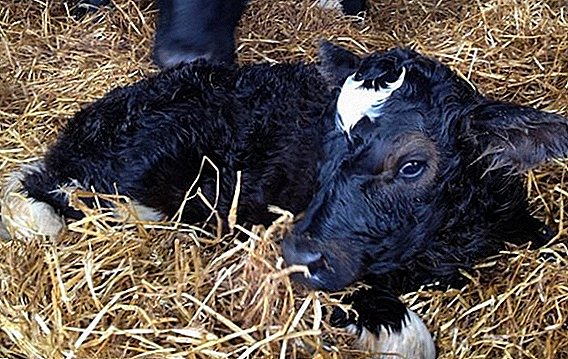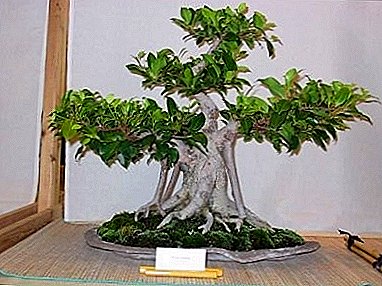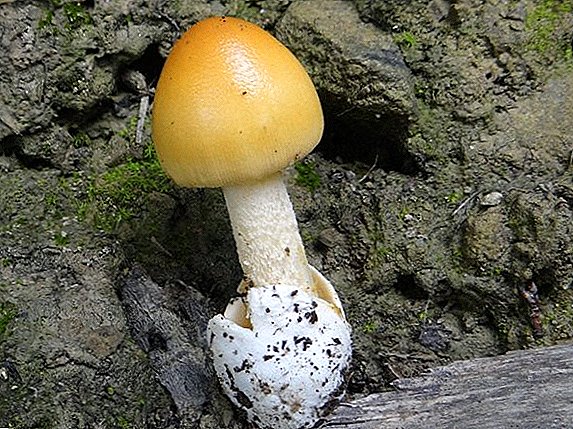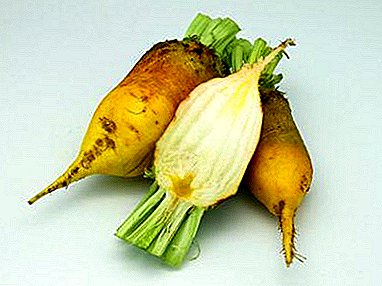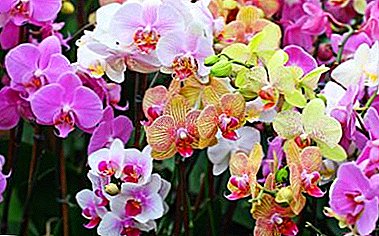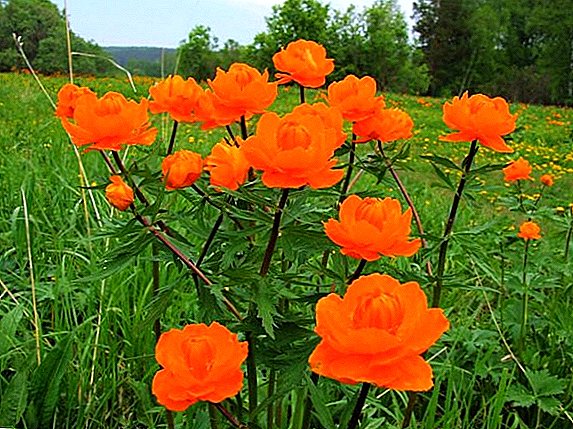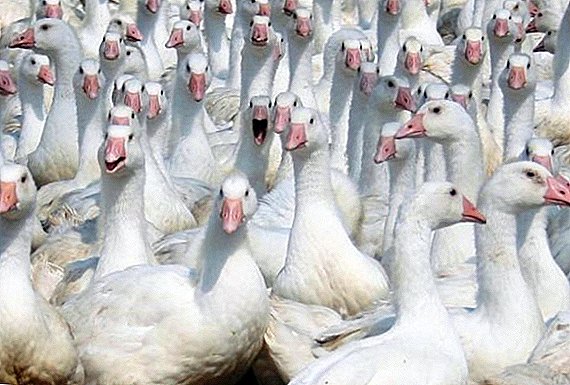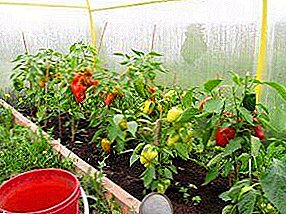
Cultivation of sweet pepper in our country practiced for a long time. The huge choice of seeds offered can confound not only beginners, but also experienced farmers. Especially when it comes to growing peppers in a greenhouse.
For the full ripening of sweet peppers almost southern conditions are required sprouting Under the conditions of the Black Earth, it is advisable to grow this crop in greenhouses. Only certain varieties are suitable for this purpose.
Variety selection
This is a southern vegetable and he does not tolerate even small cold snap. Already at a temperature of less than 20 ° C, the pepper drops a significant amount of ovaries. Therefore, for a guaranteed harvest should be given preferences early and middle grades. Also, Russian breeders have brought a sufficient number of types of pepper with high resistance to temperature extremes.
The best varieties for growing in greenhouses:
Apricot favorite. Refers to the early and mid-early variety. A small compact bush and a large number of fruits on the bush. Fruits are orange, juicy, thick-walled, cone-shaped.
Agapovsky. Shrubs varieties have good yield and resistance to various diseases. The fruits are prism-shaped and have excellent taste.
Atlant. It belongs to the undersized variety, which makes it convenient for growing in film greenhouses. The elongated fruits have a wall thickness of up to 1 cm and at full maturity become saturated red. The variety is also resistant to several diseases.
Belladonna. This sweet pepper for the greenhouse, belongs to a hybrid of Bulgarian pepper. The fruits have the shape of a cube and rather thick and fleshy walls. At full maturity poured yellow. The grade possesses excellent flavoring qualities.
 Bogatyr. Suitable for growing in a film greenhouse. Excellent transport handling. It has a high content in the pulp of ascorbic acid.
Bogatyr. Suitable for growing in a film greenhouse. Excellent transport handling. It has a high content in the pulp of ascorbic acid.
California miracle. Variety is considered to be the most popular because of its versatility. Fruits are saturated red in color, weighing up to 250 g, ideal for fresh use and for canning. Not afraid of disease.
Cardinal. The height of the bush often reaches 1 meter. The fruits have a cubic shape and an unusual dark purple color. The variety is undemanding to soil conditions and resistant to common diseases.
Rhapsody. Upper first grade. Terms of fruit ripening up to 80 days. Good fruit, even under very adverse conditions. Bushes of medium height, disease resistance is good.
Greenhouse options
Metal
- Considered more durable and durable material. But it is much higher than the wooden one.
- It has a rather complicated and heavy construction, consisting of fittings, shaped pipes and a metal frame.
- It is bolted together and can be disassembled at any time.
- Strong corrosivethat entails additional costs for the maintenance of metal parts.
- Welding can be done only by a professional.
Wooden
- Can be made amateur from scrap materials.
- Serves just a few seasons.
- Not strong enough reacts to temperature drops.
- Requires painting to protect the wooden parts of the frame.
- Wood is an environmentally friendly material.
Greenhouses can be film, polycarbonate and glass. If planting peppers is planned all year round or in early spring, then the greenhouse should be of thick glass. For later growing of seedlings, an easy greenhouse made of a film in several layers will suffice.
Film

- film easy to mount and also easily and quickly cleaned when necessary;
- most often film coatings are used for wooden frames or for temporary coating of metal;
Cellular Polycarbonate
- polycarbonate has honeycombsthanks to which the greenhouse evenly gets warm;
- equally well suited for wooden and metal frames;
- this material more reliably keeps heatthan a simple film.
Growing sweet peppers in a polycarbonate greenhouse is becoming more and more common because of the simplicity, reliability and low cost of materials.
Glass
- as a cover for greenhouses glass is little usedtaking into account the high cost of the material and installation difficulties;
- exceptions are structures made on the basis of old window frames. In this case, the task is facilitated;
- glass fits only for wooden frames;
- There should be a certain climate in the greenhouse, which includes heating, if the greenhouse works all year round and ventilation is necessary to prevent excessive humidity;
- Early spring and winter light is not enough for growing fruits and therefore care should be taken to artificially increase daylight hours;
- The irrigation system can be installed automated or manual. But in any case, no extra tools can not do.
Features of growing
Soil preparation
How to grow sweet peppers in the greenhouse? Before planting seedlings in the greenhouse you need prepare the ground well. It is necessary to make potash and phosphate fertilizers. It is not recommended to add fresh manure, as this may cause a significant drop in yield. Instead of manure, humus and compost per 10 l per 1 m² is well suited.
Can not fertilize for landing all the soil, and plant the seedlings in special plastic bags filled with nutrient mixture. This will create an additional greenhouse effect and protect the plant roots from external adverse effects.
Planting time

Permanent seedlings of peppers planted when there will be 12-14 leaves and a rather sturdy and thick green stem is indicated. The approximate height of the formed young bush should be about 25 cm.
Considering that the pepper reacts negatively to transplantation, the best way to plant seeds in peat cups.
Landing pattern
Planted plants need to be formed beds, the distance between which must be at least a meter. Planting density depends on the height of the variety.. Between high bushes a distance of about 35 cm is required, and 15 cm is enough for low ones. Such a distance is necessary so that adult bushes do not shade each other and do not tangle with each other.

Top dressing
Good harvest of peppers requires competent feedingwhich occurs in two stages. The first time it should be done in the period of active flowering. For this purpose, commonly used solution of bird droppings or mullein in liquid form. The ratio of fertilizer and water is 1:15. After this, the solution must be infused for 5-7 days.
Before feeding seedlings well pour warm water. If organic fertilizers are not at hand, they can be replaced with a solution of superphosphate, ammonium nitrate 40 g each and potassium sulphate 20 g per bucket of water. The second feeding is during the period of fruit set.
In this case, the most organic mixture is desirable. For it you need to take 200 grams of urea, half a bucket of bird droppings and 10 liters of manure last year. This mixture is diluted in 100 liters of distilled water and left for a week. After this feeding is ready.
Watering rules
Peppers are plants that need constantly wet soil.
This culture is contraindicated for irrigation with sprinkling, as it adversely affects pollination and ovary formation.
- optimally water the peppers in the morning or evening;
- watering should be carried out only with warm water;
- the formation of a crust must not be allowed in the soil around the plant;
- water should not be more often than two times in 7 days during the period of the ovaries and active fruiting;
- After planting seedlings, irrigate the peppers every two days.
Given the characteristics of this rather whimsical culture, drip irrigation method is the best way to irrigate peppers. These plants respond well to competent watering. But you should know that lack of moisture can cause gray rot in the plant, and an excess of moisture will lead to rotting of the roots.
Care and Paschkin
 In the spring, when it is already hot during the day, and at night the temperature is still very low, it becomes especially actual airing greenhouses. Due to the temperature difference in the greenhouse condensate forms, which affects the plants in the most negative way.
In the spring, when it is already hot during the day, and at night the temperature is still very low, it becomes especially actual airing greenhouses. Due to the temperature difference in the greenhouse condensate forms, which affects the plants in the most negative way.
Airing is recommended in the morning and evening, which will allow the air in the greenhouse to warm up evenly. In addition to proper watering and nutrients, peppers timely pasynking required.
This significantly increases the yield of the plant, since the side shoots take away a lot of strength and the result of which will be small fruits.
- As long as the seedlings of peppers are below 25 cm, then nothing is worth doing. After the plant reaches the desired mark, pinch top. This is done so that later the bush is more compact and thick;
- on the bush you need to choose the strongest and largest shoots and leave them in the amount of 5-6 pieces. Rest, rising below, remove;
- to prevent the development of additional processes on the abandoned stepchildren.
To grow sweet and juicy pepper - a whole science. But if you adhere to all the rules of planting and care, then get a good harvest will be not too difficult.
Useful tips in the video:


